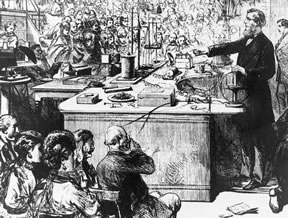One of the enduring myths about climate change is that the science isn’t settled, that we don’t know enough yet to be sure that human activity is actually disrupting the climate. It’s true that climate science is unfolding on a daily basis, and that we’re learning new things all the time, but the basics are solid. At the heart of climate science are some very old and well established principles:
1774 – Joseph Priestly identifies carbon dioxide by observing the behaviour of gases in the brewery next door to his home. He refers to it as ‘heavy air’, and discovers that plants thrive in it, while animals suffocate. Along the way, he invents soda water.
1827 – French physicist Jean Baptiste Joseph Fourier realises that, being so far from the sun, the earth should by rights be colder than it is. It must, he concludes, have some kind of insulation around it to trap the incoming heat. He coins the term ‘greenhouse effect’ to describe the phenomenon, because “the atmosphere acts like the glass of a hot house.”
1856 – Eunice Newton Foote, sometimes described as the ‘mother of climate science’, identifies the warming effect of CO2 and that it has implications for the global atmosphere. Though she would be the first to connect CO2 and global warming, her breakthrough findings are usually attributed to John Tyndall.
1859 – Drawing on Foote’s work, John Tyndall explained how heat travels through different gases in different ways. Heat passes straight through hydrogen and oxygen, but is slowed and contained by water vapour and CO2, even in small amounts. This explained the greenhouse effect that Fourier and others had suggested. The earth is warm enough to support life because the gases in the atmosphere trap heat.
1896 – Svante Arrhenius presents a paper to the Stockholm Physical Society ‘On the influence of carbonic acid (CO2) in the air upon the temperature on the ground.’ He is the first to put the various pieces together and propose that the CO2 emissions from industry, particularly the burning of coal, could affect the temperature of the earth. Being from Sweden, this was a positive prospect: “By the influence of the increasing percentage of carbonic acid in the atmosphere,” he wrote, “we may hope to enjoy ages with more equable and better climates, especially as regards the colder regions of the earth.”
1938 – Arrhenius’ work was overlooked at the time, and it was Guy Stewart Callendar who re-discovered it and put it to the test. He was the first to measure the changes in the earth’s temperature and assess the role of CO2 in those changes. A clear warming trend was already visible in the early decades of the 20th century.
1950s – Being mostly based in the temperate regions of the northern hemisphere, early pioneers of climate change often considered warming to be a good thing. Canadian physicist Gilbert Plass showed how a warmer climate is also a drier one. This news piece on Plass, from a 1953 issue of Time magazine, shows just how much was known even then: “For centuries to come, if man’s industrial growth continues, the earth’s climate will continue to grow warmer.”
1958 – Charles Keeling begins his CO2 measurements at Mauna Loa in Hawaii, and soon discovers that carbon dioxide levels change throughout the year. Levels rise as plants die back in the winter, and fall as plants grow and use more CO2 in the spring and summer. The earth ‘breathes’, giving CO2 levels a rising and falling wave pattern. His measurements also show consistently rising levels of CO2 in the atmosphere.
1965 – After a warning from his Scientific Advisory Committee, President Lyndon B Johnson warns the US that “this generation has altered the composition of the atmosphere on a global scale” through “a steady increase in carbon dioxide from the burning of fossil fuels.” The climate is recognised as an issue of national importance, with a need for political action.
1988 – The UN sets up the Inter-governmental Panel on Climate Change, a scientific reviewing body designated with providing an impartial summary of the science to inform global negotiations. It’s first report forms the foundation of the beginning of international climate talks in 1990.
2007 – The fourth report from the IPCC finds that global warming is “unequivocal”, and that there is a 95% chance that human activity is a factor. The panel, which consists of thousands of contributing scientists and hundreds of authors, jointly received the Nobel peace prize, in a year which marked a new high point of global attention to the issue.
Where are we now? Building on these foundations, scientists have continued to explore the ramifications of a warming world and how we address it. What to do about it has been, as you might have noticed, a fraught conversation. International talks failed in Copenhagen in 2009, and were succesful in Paris in 2015, giving us a compromised but nevertheless useful framework for reducing global emissions. Emissions are yet to peak and begin their decline.
For a full history of climate science, and our response to it, see Alice Bell’s rather good book Our Biggest Experiment.


Thanks Jeremy.